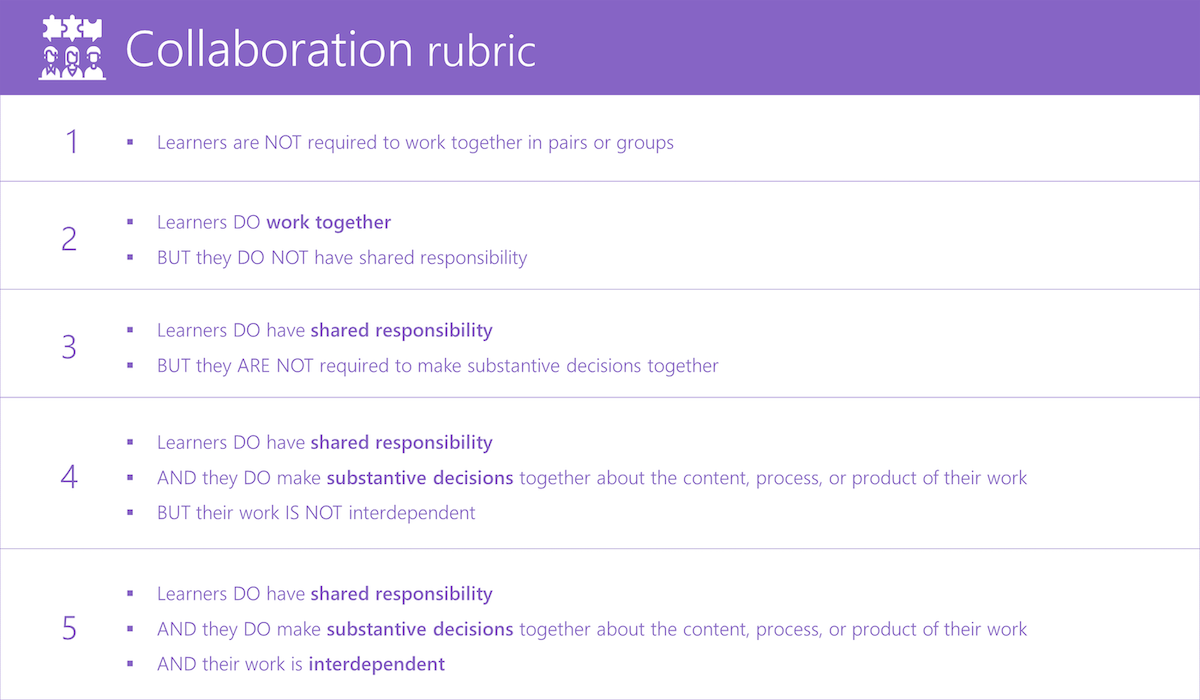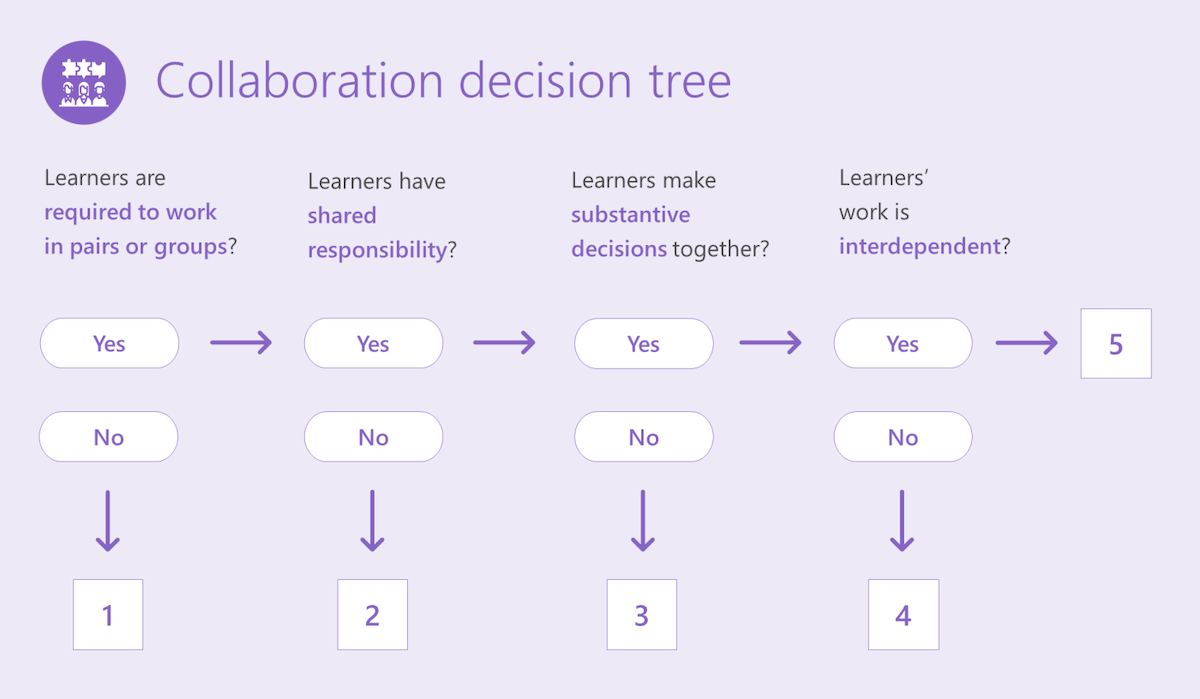Design learning experiences with the collaboration rubric
The 21CLD collaboration dimension examines whether learners are working with others on the learning activity and the quality of that collaboration. Many distinct levels of collaboration exist, and educators must be aware of what level or type of collaboration they expect their learners to engage in. Simply putting learners into groups or pairs doesn't necessarily mean they are going to collaborate. The clearer educators communicate about the type of collaboration their learners need, the more likely learners will develop the type of skills necessary to collaborate effectively.
The collaboration rubric captures the big ideas of collaboration and serves as a framework for designing collaborative activities. Each level of collaboration (one to five) is described within the rubric:

Go to Rubric – Collaboration for an accessible version of the rubric.
The collaboration decision tree poses questions related to the concepts in the rubric. When designing activities that incorporate collaboration, educators must consider the following questions:
- Are learners working together?
- Do they have shared responsibility?
- Do they make substantive decisions together?
- Is their work interdependent?
Answering these questions will inform the design process for a learning activity that incorporates collaboration.

Go to Decision Tree – Collaboration for an accessible version of the decision tree.
Are learners working together?
For collaboration to take place, learners must work with others in the learning activity. To meet this level of collaboration, learners must work in pairs or groups to:
- Discuss an issue,
- Solve a problem, or
- Create a product.
When learners work together, they may be working face-to-face or using technology to share ideas or resources. Their collaboration might also include people from outside the class, including:
- Learners from other classes,
- Children from another school,
- Community members, or
- Experts in the field.
The following scenarios don't meet the requirement of learners working together:
- Learners doing their work alone
- A whole class discussing an issue
- Each learner creating his/her own story and sending it to the educator for feedback
The following scenarios meet the requirement of learners working together:
- Pairs of learners giving each other feedback
- A small group discussing an issue together
- A learner using Microsoft Teams to interview a peer in another town via the Internet
- Learners using OneNote to share their story and give each other feedback
Do learners have shared responsibility?
To reach a deeper level of collaboration, learners also need to have shared responsibility for their work. They have shared responsibility when they work in pairs or groups to develop:
- A product,
- Design, or
- Response.
Shared responsibility is more than simply helping each other. Learners must collectively own the work and be mutually responsible for its outcome. If the group work involves learners or adults from outside the class, this qualifies as shared responsibility only if the outside participants are mutually responsible for the outcome of the work.
The following scenarios don't meet the requirement for shared responsibility:
- Learners giving each other feedback. This activity structure implies that one learner “owns” the work and the other is only helping.
- A learner interviews a peer in another country/region about the local weather. This is a task that learners conduct together, but they do not have mutual responsibility for its outcome.
The following scenarios meet the requirement for shared responsibility:
- Learners conducting a lab experiment together. Learners have joint responsibility for carrying out the lab experiment.
- A learner working with a peer in another country/region to develop a joint website using Microsoft Office 365. The learners share responsibility for the development of the website.
Do learners make substantive decisions together?
At a deeper level of collaboration, learners also need to have the opportunity to make substantive decisions together. Learners make substantive decisions together when they must resolve important issues that will guide them as they work together. Substantive decisions are decisions that shape the
- Content,
- Process, or
- Product of the learners' work.
Learners make substantive decisions regarding content when they use their knowledge on a topic to make a decision that affects the academic content of their work together. For example, a group taking a stance on a topic they will write about is making a substantive decision together. Similarly, a group deciding on a hypothesis that they will test in an experiment meets the substantive decision requirement.
With regard to process, to make substantive decisions together, learners must plan:
- What they will do,
- When they will do it,
- What tools they will use, and
- Who will complete each task.
Finally, to make substantive decisions about their product, learners must make fundamental design decisions that affect the nature and usability of the product.
The following scenarios don't meet the requirement for substantive decisions:
- Learners working together to identify capital/major cities of countries/regions in Europe. This decision doesn't affect the rest of their work.
- Pairs of learners choosing which animal they will study. Learners will probably make this decision based only on personal preferences, not on their knowledge of the subject.
- Teams assigning roles to team members based on the list of roles the educator has defined. The educator has planned the process of their work, not the learners.
- Pairs of learners selecting a color scheme for their presentation. Decisions about surface features aren't considered substantive decisions that fundamentally affect product design.
The following scenarios meet the requirement for substantive decisions:
- Learners in teams are preparing for a debate and must decide what side of the issue they will argue. This is a content decision that will shape their work together and learners must negotiate their ideas.
- Pairs of learners are developing a presentation about climate change and must decide what causes to write about. Learners must decide together what the most important causes are; this decision will shape their presentation.
- Teams are conducting a research project and must decide on their own work plan and roles on the team. Learners must plan the process of their work.
- Pairs of learners decide how to shape their presentation to a particular audience. This is a fundamental design decision that will affect the nature of their overall product.
Is learners' work interdependent?
The strongest learning activities are designed so that learners' work is interdependent, requiring all members to contribute for the team to succeed. Too often, a group of learners may share responsibility for an outcome, but in practice the work isn't divided fairly. One or two learners may do all the work for the team. It may be challenging to design learning activities that require the participation of all team members. To meet this criterion, learners must produce an interdependent product. This may be a presentation that they each share in developing and presenting, or the responsibility of a decision that requires information to be distributed across all team members.
Most interdependent work involves two levels of accountability:
- Individual accountability: Every member of the team is responsible for a task that he or she must complete for the group to succeed; therefore, the role of each learner on the team is essential.
- Group accountability: Learners must work together to produce the final product or outcome; they must negotiate and agree on the process design and conclusions of their work.
The work must be structured in a way that requires learners to plan together and consider the individuality of each member’s work so that their product or outcome is complete and cohesive.
The following scenarios do not meet the requirement of interdependent work:
- Group members work together to research frogs, but each learner conducts their own dissection and writes their own lab report. Learners work together on the research component, but the products don't require input or participation from others.
- One learner uses a device to plot coordinate points and create a star shape with input from group members. Only one learner is plotting coordinates; the others may contribute, but they could also disengage without preventing the group from completing the product.
- Learners each create a webpage about the history, culture, attractions, or accommodations of their local area that will be linked to the class homepage. Learners don't have to strategize together in any particular way.
The following scenarios meet the requirement of interdependent work:
- Group members each research a different internal system (e.g. circulation, digestion) of frogs. Learners then work together to dissect a frog and write a lab report about the dissection, identifying the parts of the frog and the systems to which they belong. Learners rely on each other's work to successfully identify what they see during the dissection.
- Learners each use their own networked device to contribute coordinate points that collectively create the shape of a star. Each learner's contribution is necessary so the group can create the completed shape.
- Learners create a tourist website presenting the history, culture, attractions, and accommodations of their local area. Everyone might create a different piece of the overall website, but learners need to work together to determine how to organize the information to create the best possible website.
But what do each of these big ideas look like in action?
Practice coding one of the anchor lessons in the 21CLD OneNote notebook by taking these steps:
- Review the MakeCode Arcade Coding Project learning activity page
- Consult either the collaboration rubric or decision tree and code the lesson
- If working with colleagues during this module, discuss your findings
- Refer to the video to compare your analysis with Becky's explanation in the following video:
Bonus: To better prepare for the Microsoft Certified Educator Exam, practice coding more anchor lessons. Suggested activities in the anchor lesson section:
- House on Mango Street
- Olympics Site Selection
- Mr. Sun. E. Day
When you finish coding the lesson, review the coding results summary in the anchor lesson section to compare your findings to others.